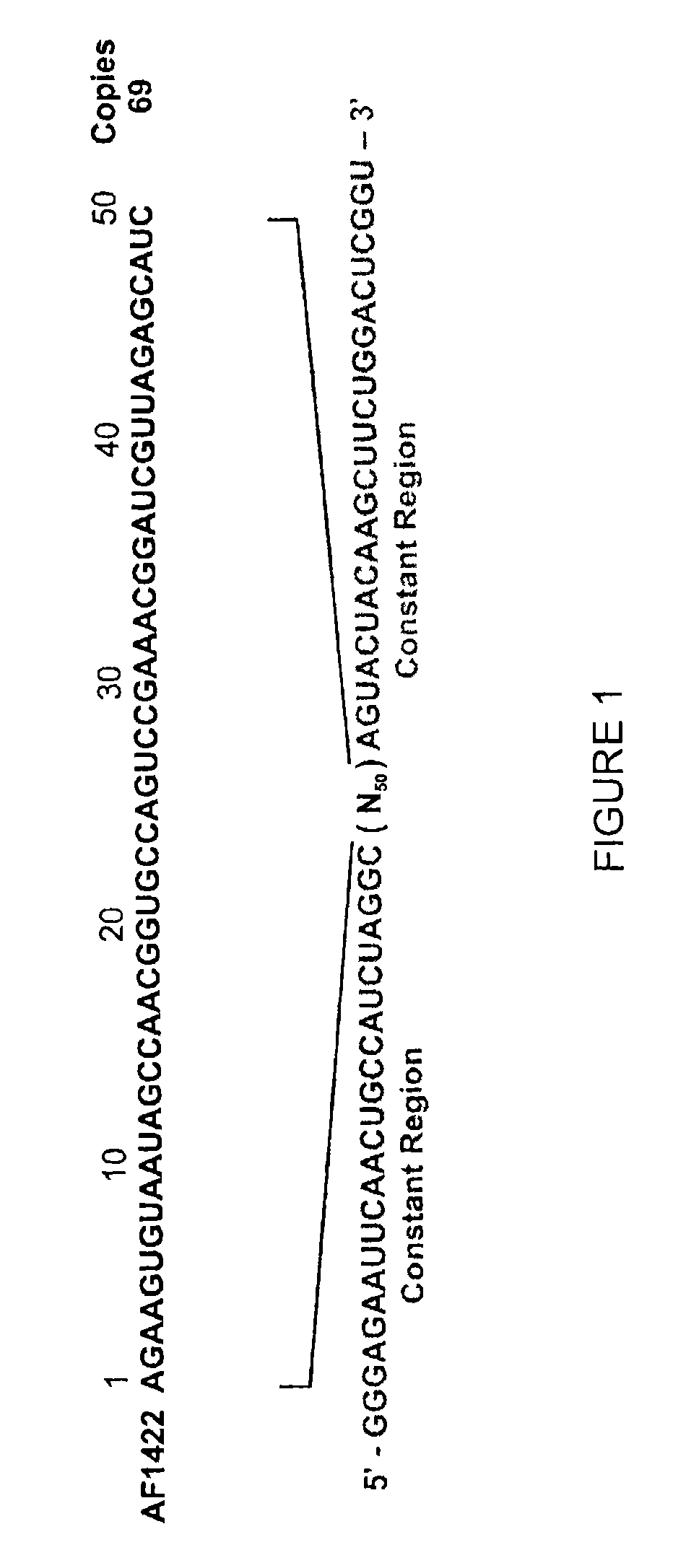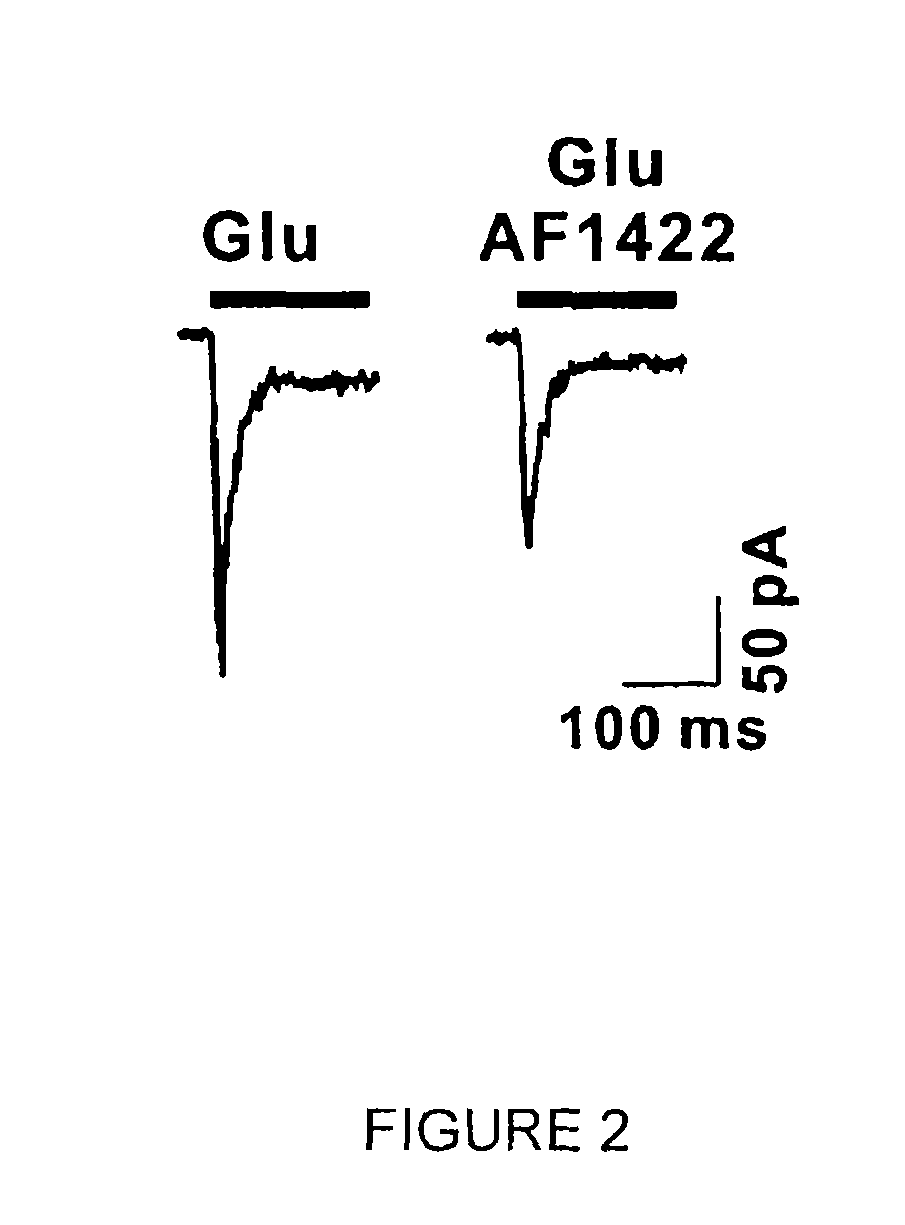Subunit-selective nucleic acid inhibitors of glutamate receptors
a glutamate receptor and subunit-selective technology, applied in the field of nucleic acid ligands, or aptamers, can solve the problems of lack of inhibitor-receptor interactions within the time domain of microsecond (s) to millisecond (ms) and the number of glutamate receptor inhibitors currently availabl
- Summary
- Abstract
- Description
- Claims
- Application Information
AI Technical Summary
Benefits of technology
Problems solved by technology
Method used
Image
Examples
example 1
Receptor Preparation
[0084]To ensure that the aptamers to be identified would recognize functional GluA2Qflip AMPA receptors, cDNAs encoding various subunits of glutamate ion channels were used for transient receptor expression in human embryonic kidney (HEK)-293S cells (45). The cell culture, transfection, and preparation of membrane lipids containing functional, intact GluA2Qflip receptors for aptamer selection were carried out according to protocols known in the art. Briefly, GluA2Qflip receptor was transiently expressed in human embryonic kidney (HEK) 293S cells. These cells were co-transfected with the simian virus 40 large T-antigen (TAg) gene to enhance receptor expression, in accordance with materials and methods known to those of skill in the art.
[0085]For SELEX, the membrane-bound GluA2Qflip receptors were harvested 48 hours after transfection (45). Specifically, the HEK-2935 cells were homogenized briefly in a cold, 50 mM Tris-acetate buffer (pH 7.4) containing 10 mM EDTA ...
example 2
Aptamer Selection by SELEX
[0086]The operation of SELEX is well known in the art and has been described previously supra. In each round of SELEX (a total of 14 cycles were used), a combinatorial RNA library with ˜1015 random sequences was first dissolved in 1× extracellular buffer (145 mM NaCl, 3 mM KCl, 1 mM CaCl2,2 mM MgCl2, and 10 mM HEPES pH 7.4). The final concentration of membrane-bound receptor in the binding mix was 8 nM, as determined by [3H]AMPA binding. The binding mixture was incubated at 22° C. for 50 minutes in the presence of 0.3 units / μl RNase inhibitor. For elution, 1 mM (final concentration) of 1-(4-aminophenyl)-3-methylcarbamoyl-4-methyl-7,8-methylenedioxy-3,4-dihydro-5H-2,3-benzodiazepine, which we termed as BDZ-f, was used. The eluted RNAs were subjected to reverse transcription-PCR. To suppress enrichment of nonspecific RNAs bound to any unwanted “targets”, such as lipids, three negative selections at rounds 4, 8, and 13 were run in which plain HEK-293 cell memb...
example 3
Identification of the Minimal, Functional Aptamer Sequence: AF44 and AF42 Inhibitor Pair
[0091]Guided by Mfold, an RNA secondary structure prediction program (46), a number of shorter versions of AF1422 were constructed in order to identify the minimal, yet functional RNA sequence (FIG. 4).
[0092]To create shorter pieces of RNAs, the predicted secondary structures that were thought to be important were preserved. For example, AF78 was constructed to test whether the stem-loop structure, comprised of the initial 20 or so nucleotides at the 5′ constant region, played any functional role. The fact that AF78 turned out to be non-inhibitory suggested that this region was essential for inhibition by AF1422. However, AF20, which contained only this stem loop, was not sufficient to inhibit either alone or together with AF42 as an inhibitory pair.
[0093]To create AF44, the projected secondary structure of AF1422 was modified in the following way. First, the stem formed from U19 / G99 to U31 / G86 w...
PUM
| Property | Measurement | Unit |
|---|---|---|
| current amplitude | aaaaa | aaaaa |
| current amplitude | aaaaa | aaaaa |
| current amplitude | aaaaa | aaaaa |
Abstract
Description
Claims
Application Information
 Login to View More
Login to View More - R&D
- Intellectual Property
- Life Sciences
- Materials
- Tech Scout
- Unparalleled Data Quality
- Higher Quality Content
- 60% Fewer Hallucinations
Browse by: Latest US Patents, China's latest patents, Technical Efficacy Thesaurus, Application Domain, Technology Topic, Popular Technical Reports.
© 2025 PatSnap. All rights reserved.Legal|Privacy policy|Modern Slavery Act Transparency Statement|Sitemap|About US| Contact US: help@patsnap.com



